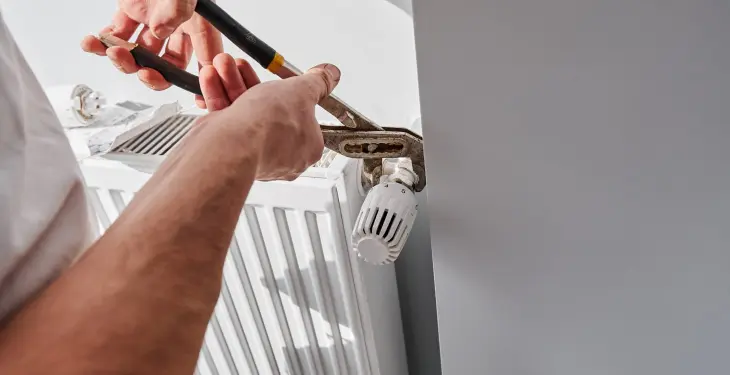

Written by Stephen Day
Gas Safe Engineer
Updated: 30th May, 2025
A header tank, also known as a feed and expansion tank, serves an important role in an open vented central heating system. It supplies water and accommodates the water's expansion as it heats.
Get a new boiler quote, save up to £550 per year (0% APR available).
Header tanks are a crucial part of many UK homes, especially in older properties with traditional central heating systems. These tanks help regulate the water supply and pressure for systems, including showers and radiators. However, an overflowing header tank can be a common and frustrating problem, often indicating issues that need urgent attention. Addressing the overflow quickly can prevent potential water damage and ensure the heating system functions efficiently.
When the water level rises too high, it can cause the tank to overflow, leading to water wastage and possible damage. This might happen due to a faulty ballcock or float valve, which fails to control the water inflow. Moreover, excess air trapped in the system or a blockage in the overflow pipe could also lead to overflows. Understanding how these components work together is key to identifying and solving the problem.
There's a straightforward fix to this issue: shut off the main water supply and drain the tank. Once empty, it’s vital to clean out any debris or sludge and inspect components like the float valve. Regular maintenance and inspection can help to prevent future overflow issues, ensuring the header tank continues to function as intended.
Get a quote in 60 seconds, fitted as fast as next day!
0% APR finance available.
A header tank, often found in homes with open vented central heating systems, can overflow for several reasons. Understanding these causes can help in addressing the problem effectively.
Faulty Ballcock Valve: In many cases, a malfunctioning ballcock valve is to blame. This valve controls the water level within the tank. If it becomes stuck or fails, it may allow excess water to enter, leading to overflowing.
Excessive Water Pressure: High water pressure can also cause the header tank to fill more than necessary. This pressure could result from recent changes in plumbing or an adjustment in the water mains.
Leaks in the Heating System: If there are leaks in the central heating system, they can cause the tank to refill constantly. This continuous refilling might eventually lead to overflow as the system attempts to maintain the water level.
Incorrect Positioning of the Tank: Sometimes, the header tank might be incorrectly positioned, which can affect its ability to function properly. If the tank is not at the correct height, it may impact water flow and pressure.
Blockages: Blockages in the overflow pipe or related plumbing can prevent the system from releasing excess water, leading to overflow issues.
Inspecting the header tank regularly and addressing any faults can help prevent these problems from becoming severe. Simple adjustments, like bending the ballcock arm, might also resolve minor issues. If unsure, seeking professional assistance is always a wise choice to ensure central heating operates smoothly without causing damage.
A header tank, also known as a feed and expansion tank, serves an important role in an open vented central heating system. It supplies water and accommodates the water's expansion as it heats.
Water Supply: Header tanks provide a steady supply of water to the heating system. They feature a float valve for maintaining the water level.
Expansion Management: Water expands when heated. The header tank allows for this expansion, preventing damage.
Position: Typically found at the highest point of the building, often in the loft.
Materials: Commonly made from materials like copper or plastic to withstand temperature changes.
Float Valve: This ensures that the water level is consistently maintained.
Overflow Pipe: Protects against overfilling by directing excess water safely away.
Header tanks work alongside hot water cylinders and coils. They differ from cold water tanks, which mainly supply cold water to various parts of the house.
The tank connects through a system of pipes to various components, including the hot water tank and central heating system.
Understanding the role of header tanks in heating systems helps homeowners maintain their heating efficiency. They ensure reliable water supply, safe expansion handling, and protect against overflowing.
Header tank overflow is often linked to issues like faulty float mechanisms, incorrect pump settings, freezing conditions, and blockages caused by debris. Understanding these causes can help in troubleshooting and fixing the overflow efficiently.
A faulty float mechanism is a common reason for header tank overflow. The float, often connected to a ball valve, controls the water flow into the tank. When the float mechanism fails, it can lead to incorrect water levels.
If the rubber washer inside the ball valve wears out, it may not seal properly, allowing water to continuously fill the tank. This constant flow raises the water beyond the safe level, leading to overflow. Regular maintenance can help identify and replace worn float valves or other faulty parts of the system.
Pump overrun can also cause header tanks to overflow. The pump usually continues running for a short period after the heating is turned off to dissipate residual heat. However, if it runs longer than needed, it can cause excess water to flow into the system.
An automatic bypass valve may become necessary if the pump overrun isn't correctly set. This device helps divert excess water pressure back into the system, preventing overflow. Checking the settings can ensure the pump stops at the correct time, averting overflow issues.
Freezing weather can significantly impact the functionality of header tanks. When temperatures drop, any residual water in the feed pipe or in frozen pipes can expand. This expansion is potentially damaging to the material and can lead to cracks or blockages.
If the pipes or tank components freeze, water flow might be restricted. Upon thawing, the sudden surge of water can lead to an overflow. Proper insulation of pipes and tanks is important for preventing freezing-related overflow incidents.
Grit and sludge accumulation within the header tank can obstruct systems and result in overflows. These particles blend with water and often gather at the bottom or sides of the tank. Over time, they can interfere with the float valve's operation, causing it to stick.
The unwanted sediment affects the pressure head, leading to uneven water entry, which can cause spillover. Regular cleaning of the tank is advised to prevent such build-ups. Ensuring that the brass nipple and other inlet points are clear can help maintain a steady water flow and prevent overflow.
An overflowing header tank can be caused by several issues, but it is often related to the ballcock or float valve failing to work properly.
Check the Ballcock and Float Valve
Inspect the ballcock and float valve. They should move freely without any blockage.
If the valve is faulty, replace it. This can often solve the overflow problem.
A float that doesn't sit correctly can cause overflow. Gently bend the float arm to adjust its position. This ensures the water level is correctly regulated.
If the tank is already overflowing, remove some excess water. Use the overflow pipe to drain water by opening taps to let it flow.
Examine the tank for any leaks that may contribute to overflow. Small cracks or loose joints should be repaired promptly.
If these steps do not fix the problem, seeking help from a heating engineer is advisable. They have the expertise to diagnose and fix more complex issues.
Regular maintenance of the system can prevent problems like unexpected overflows. Schedule routine checks to keep the system in good health.
Regular maintenance of a header tank is essential to prevent overflow issues. Start by inspecting the tank and its components periodically. Look for signs of wear, damage, or leaks in the ballcock, which should be at the correct level to control water flow accurately.
Insulation is crucial in protecting the tank from temperature fluctuations. During cold weather, the risk of freezing increases. By using insulation jackets, you can keep the water in the tank at a stable temperature, reducing the chances of damage from freezing or overheating.
Ensure that the water pressure entering the tank is not too high. High pressure can cause the tank to fill too rapidly, leading to overflow. Install a pressure reducing valve if necessary to maintain a suitable pressure level.
Checking for blockages in pipes is also important. Blockages can cause pressure build-up, leading to an overflow. Regular cleaning and maintenance of the plumbing system can mitigate this risk.
If any part of the tank or its components seems out of order, prompt repairs are necessary. Delaying repairs can lead to bigger problems, so act swiftly to preserve the system’s function and prevent overflow.
Consider setting up a maintenance schedule. Regular checks ensure that any developing problems are caught early, reducing the likelihood of overflow. By adopting these preventive measures, the chance of future issues can be significantly minimised.
Get a quote in 60 seconds, fitted as fast as next day!
0% APR finance available.
Last updated: 30th May, 2025

Written by Stephen Day
Gas Safe Engineer at iHeat
Stephen Day is a Gas Safe registered and FGAS certified engineer with over 20 years of hands-on experience in the heating, cooling, and renewable energy industry, specialising in boiler installations, air conditioning, and heat pump systems.
LinkedInArticles by Stephen Day are reviewed by iHeat’s technical team to ensure accuracy and reliability.

28th November, 2025
Most Hive heating issues come from lost connection, low batteries, receiver faults or boil...
 Read Article
Read Article

28th November, 2025
A leaking lockshield valve is usually caused by a loose gland nut, worn seal or corrosion,...
 Read Article
Read Article

28th November, 2025
A clear comparison of Worcester Bosch and Vaillant Boilers and why Worcester Bosch is ofte...
 Read Article
Read Article
No obligation. Takes less than 60 seconds.